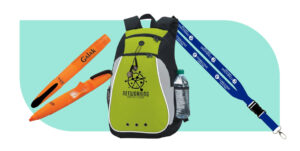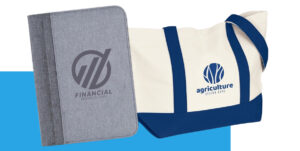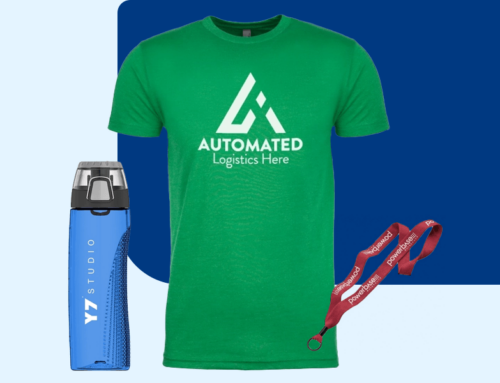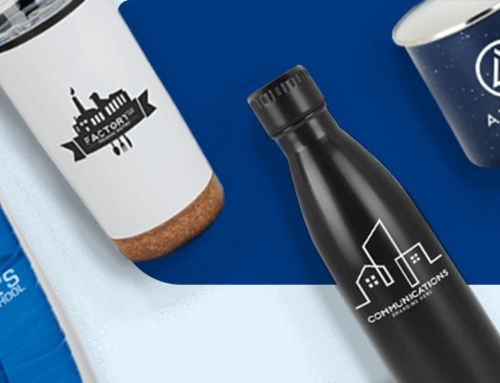06/29/2022
Types of Imprint Methods
Promotional products are an incredible tool for businesses to spread brand awareness and build relationships with their clients. They showcase your name and logo, helping you gain important brand recognition. There are hundreds of items you can brand to reflect the mission and personality of your business.
Imprinting is the technique that promotional product companies use to stamp your design onto an item. There are numerous ways to imprint a product, depending on the material. Understanding these methods will help you communicate better with designers and manufacturers so you’re always on the same page. This guide will explain the imprinting process for promotional products so you can discuss promotional product printing like an expert.

Different Types of Imprint Printing
Promotional product companies use imprinting techniques to add eye-catching graphics to different materials. Here are the most common imprinting methods:
1. Screen Printing
Screen printing — also known as silk screening — is one of the most common imprinting methods. It’s popular because it provides intense color that’s customizable to your specific needs. Screen printing is ideal for printing on items with a large surface area, but it also works on small objects. You can use screen printing to brand T-shirts, tote bags, pens, drinkware and many other promotional items.
Screen printing is clean and crisp, so your design turns out exactly how you imagined. It’s also cost-effective and easy to implement. However, screen printing is typically ideal for single-color designs because multicolor designs are tedious and must be applied in separate layers.

How Screen Printing Works
Imprinting using the silk screening method typically follows these steps:
- A designer creates a custom nylon or polyester screen with the design of your choice.
- They treat the screen with a special solution — a gelatin-like emulsion — that prevents ink from passing through the blank areas of your design. The emulsion dries when exposed to UV light from the screen printing machine to ensure your designs come out clean and precise.
- The designer lays the screen over your item and pushes the ink through the netting. The ink seeps onto the product and will only stick where the screen is left open, not where the emulsion is applied.
- Since they have to spread the ink across the entire surface, the designer can only apply one shade at a time. If your design includes multiple colors, the artist will make a different stencil for each color and apply them in layers.
2. Heat Transfer
Heat transfer printing is mainly used for clothing and other products made of fabric. A designer will print your design from a computer onto a special release paper. The printed design looks reversed on the printed paper, so it faces the correct direction when attached to the material. An industrial heat press warms up the color to ensure the design sticks to the material.
The designer can apply the entire image at once, making this one of the easiest imprint methods. The heat transfer technique is also extremely simple and cost-effective. It’s ideal for businesses that need a small number of promotional items. Promotional product companies can use heat transfer imprinting to print on shirts, blankets, jackets and tote bags.

Heat Transfer vs. Screen Printing
Heat transfer and screen printing are among the most popular imprinting methods, especially for printing on T-shirts and other apparel items. However, there are some differences between the two methods that make one preferable over the other in some instances.
For instance, while designs printed using the heat transfer method may be as clear as those imprinted using screen printing, the latter last longer. That’s because the ink used during screen-printing becomes part of the fabric and won’t fade or crack or fade. Heat transfer is still a good option if you’re looking to print sophisticated designs that feature numerous colors.

3. Dye Sublimation
Promotional product companies typically use the dye sublimation method to imprint fabric items. Dye sublimation produces excellent color reproduction on light-colored fabrics. You can use it to create promotional banners, table covers, lanyards, T-shirts, can coolers and other fabric items. With specialty transfer paper, you can also use dye sublimation on hard surfaces like ceramic mugs, ornaments and coasters.
Dye Sublimation vs. Heat Transfer
Similar to heat transfer imprinting, the designer prints the image onto transfer paper and presses it into the fabric using a heated press. It differs from the heat-transfer technique in that it uses a specialty sublimation ink. Sublimation ink is unique because it never turns into a liquid. When it’s heated, it changes from a solid to a gas.
For that reason, instead of sitting on top of the fabric, it becomes incorporated into the fibers of the fabric. As a result, it produces softer and more durable designs. The dye sublimation ink is waterproof, so it’s not easily washed off or peeled off of the printed item.
4. Offset Printing
While the offset method is known for printing newspapers, it’s also used to imprint on various materials. Although it may seem like an outdated method, offset printing produces clear and crisp designs on a range of fabrics. Businesses use offset printing to brand promotional T-shirts, napkins, banners, signs, vinyl stickers and brochures. This method is ideal for a large volume of products because most of the cost is incurred in the initial setup. The more items you imprint, the more cost-effective this technique becomes.
How Offset Printing Works
Offset printing requires a series of special equipment, including a rubber roller or blanket, to produce high-quality designs. The designer starts by creating your desired image using computer software. Only one shade of ink is applied at a time, so multicolor images are separated into four different tones. Then, each design is etched onto an aluminum plate that gets loaded into a roller called a plate cylinder.
As the plate rotates around the cylinder, the blank areas of the design are coated with water to prevent ink from sticking. Then, oil-based ink is applied to the image area. The colored image is offset to the bottom cylinder — hence the name offset printing. Now, the technician can insert the printing material. The flexible rubber rollers make it possible to print on rough surfaces, including fabric, canvas, leather, metal and wood. This process is completed for all four colors to create the final image.
5. Laser Engraving
Laser engraving is a modern imprinting method that uses extreme heat from a laser beam to etch your design onto a hard surface. It’s ideal for branding promotional products that are resistant to ink, such as glass, metal, leather and wood. This technique removes the top layer of material, leaving a permanent image. No ink or color is involved in this process. The color of the finished image depends on the base material.
Glass engravings appear white, while wood and metal engravings turn a darker shade. You can use laser engraving to add your brand’s name and logo to mugs, water bottles, tumblers, pens, pocket knives, wine glasses and cutting boards. While laser engraving is more expensive than most of the other printing methods, it has many advantages, including:
- A computer controls the laser, creating exceptionally intricate and precise designs.
- Works on almost any material, provided you don’t need color.
- Can be used alongside other imprinting methods.
- Creates sleek, permanent and professional marks.
- Designs stand the test of time and are extremely durable against scratches and wear and tear.
- Elevates the look of your promotional items, giving them a premium and high-end look.
6. Chemical Etching
Chemical etching is an increasingly popular method to imprint various promotional items. This technique is similar to laser etching, except it uses an acidic spray to remove the top layer of material and reveal clearly etched designs. Chemical etching only works on metal materials, such as steel, copper, aluminum and nickel.
This method boasts impressive design flexibility and low tooling costs and is suitable for high-volume production. Designers use this complex technique to print promotional items like signs, nameplates, awards, jewelry and key chains.
How Chemical Etching Works
Professionals use an etching machine to make this technique safe and efficient. Here’s the process they follow:
- The technician creates a computer file with the image of your choice. Using black ink, they print the design onto a transparent plastic sheet called a photo tool.
- Then, they coat the metal material with a photoresist (or resist) film, which acts as a barrier against the acid.
- The technician layers the photo tool on top of the coated metal and places it under ultraviolet (UV) light. The light will harden the photoresist material over the exposed areas, protecting it from the acid. The shaded regions remain soft so the chemicals can etch the surface.
- The technician washes away the soft material to prepare the metal for the etching phase.
- Then, they treat the metal with the etching chemical. The acid corrodes the exposed areas and washes away the debris. The material beneath the resist material is unaffected.
- The technician removes the remaining resist material, revealing your finished design.
7. Pad Printing
Promotional product companies use pad printing to brand various materials of all shapes and sizes. Pad printing is a simple and efficient process that involves stamping designs onto all types of promo products using an automated machine. A flexible silicone stamp is dipped into an ink-covered inset plate engraved with your custom design. The ink from the plate transfers to the stamp and is pressed onto the item of your choice.
Pad printing is typically used to apply single-color images. However, you can layer colors and designs by swapping out the ink and inset plate between stamps. It’s preferred for printing small designs that are too intricate for screen printing on all kinds of merchandise, including promotional drinkware, ice molds, push pop balls, phone wallets and stress balls. Pad printing has many advantages:
- It’s excellent for printing on 3D or oddly shaped items that are more challenging to customize.
- It’s an incredibly affordable method that still produces crisp designs.
- It’s ideal for transferring 2D images to 3D products.
- It’s compatible with many materials, including rubber, metal, glass, plastic and edible products.
- It’s a cost-effective imprinting technique.
8. Embroidery
Embroidery is an ancient technique that people have used for centuries to decorate various textiles. It was traditionally done by hand using a needle and thread. Today, embroidery machines are used commercially to brand promotional items. The designer creates a custom pattern on the computer, and the machine does the actual stitching.
Businesses typically use embroidery for uniforms and promotional apparel. You can stitch your name and logo onto almost any fabric. Choose embroidery to create promotional hoodies, gloves, hats, blankets or bags.
Here are some of the main advantages of embroidery:
- It lasts much longer than ink methods and looks high-end.
- It allows for numerous colors in a design at no extra cost.
- High-quality embroidery thread retains color very well.
- It works well with materials that don’t print well, like fleece and heavy cotton.
On the flip side, embroidery is more expensive than ink printing methods. It also limits the types of designs you can produce, as it’s not suitable for small and intricate designs or large, gradient designs. Additionally, threads may start unraveling after some time because of wear and tear.

9. Full-Color Process and Digital Printing
Full-color process, or digital printing, is the preferred method for printing elaborate designs with different colors. This technique creates detailed images by layering cyan, magenta, yellow and black ink. It’s ideal for printing artwork and photographs with intricate shading and gradients. Digital printing creates clean designs with minimal turnaround times and setup costs.
You can use digital printing to add graphics to flat materials like paper, fabric and thin plastic. You can also use digital printing to create promotional labels for 3D items like drinkware and hand sanitizer. This method is also popular for branding promotional bags, tumblers, T-shirts, mouse pads and logo magnets.

How Full-Color Processing and Digital Printing Works
A specialty printer is required for full-color processing. The designer uploads your image onto the computer and sends it to the machine. It prints your design directly onto the product of your choice. Digital printing makes your color options limitless and reduces the time spent color matching before printing.
10. Embossing and Debossing
Embossing and debossing methods use pressure and heat to stamp an image onto your promotional products. They use a metal-engraved die to give the surface dimension and make your design pop. Embossing uses indented stamps to create a raised design, while debossing uses raised stamps to create an indented design. These techniques work on a limited number of materials, such as leather, plastic, metal and card stock.
These methods offer a unique way to add your name and logo to wristbands, folders and padfolios. They create a permanent imprint without using ink, resulting in a product that lasts longer than ink-printed designs. However, embossing and debossing are more expensive than ink printing, and the designs are not easy to see from a distance.
How Embossing and Debossing Work
For this technique, the artist will create a custom die or stamp that fits inside a special pressing machine. They insert the material into the machine and press the stamp onto the surface. You can add a layer of foil or transparent film to add detail to your design. The two materials will stick together, creating a metallic or glossy finish over the image.
11. Foil Printing
Designers often combine foil printing with embossing or debossing, but this technique also looks great by itself. The only difference is that the surface underneath remains flat. A heated die presses the foil onto the material, leaving behind a shiny custom design. The result is a striking image with a slight 3D effect. Foil printing is a popular choice for imprinting promotional shopping bags, napkins, greeting cards and folders.
Other Things You Should Know About Imprints
Now that you understand the most common types of imprints, here are some helpful points to help you plan and organize your corporate product printing:
1. Material Matters
When you’re investing in custom promotional products for your business, you want them to look clean and vibrant. Keep in mind that the quality and appearance of your logo may change depending on the material you choose. For instance, a bright yellow logo will transfer beautifully onto a white ceramic mug. However, the color may appear differently on a screen-printed T-shirt. Ask your customer service expert to help you choose a material compatible with the look you’re trying to achieve.
2. Price Varies
Keep your budget in mind when you’re choosing an imprint method. Techniques like engraving, embroidery and embossing typically cost more than pad printing, silk screening and heat transfer. While pricier methods often yield premium results, cost-effective options can be equally impressive.
4. Location Shifts
The manufacturer typically predetermines the location where you can imprint the product. It varies depending on the size and shape of the item. For instance, on a pen, your logo typically goes on the center of the barrel. In some cases, there are multiple locations where you can add your name and logo.
5. Size Fluctuates
The size of the image you can imprint also fluctuates depending on the item. Large items like a banner or T-shirt have plenty of room for your name and logo. Alternatively, a package of mints may only fit a small design.
How to Choose the Best Imprint Method for Promotional Products
The choice of the best imprint method requires you to consider many factors:
- Budget: How much are you willing and able to spend? Who are the items for, and when will you gift them? Some options, like offset printing, are more budget-friendly and suitable for high-volume production of merchandise headed out during trade shows and exhibitions.
- Printing quality: Some imprinting methods produce high-quality or more durable designs than others. For example, screen printing designs last longer than heat transfer printing designs.
- Product material: The product’s material determines the types of imprinting methods that may or may not be used. Embroidery is an example of an imprinting design that’s only suitable for fabric promotional items, while chemical etching can only be used with metallic products.
- Color: Some methods are more suitable for color printing than others. For example, while digital printing is ideal for detailed and colorful designs, laser engraving is perfect for etching durable designs without color.
Professional Imprinting From ePromos
At ePromos, we have a team of experts to do all the hard work for you. We preselect the appropriate imprint method for our promotional products so that your design turns out beautifully every time. Our designers will guide you through the process and help you understand what to expect. We make it simple and convenient to plan all your corporate product printing.
Our expert consultants will help you navigate our extensive inventory to help you find products imprinted with your desired technique. They use their extensive knowledge and training to ensure that your project is successful. We provide free samples, digital proofs and artwork cleanup so you can place your order with confidence. Contact us for more information, or browse our selection of premium promotional items today!








